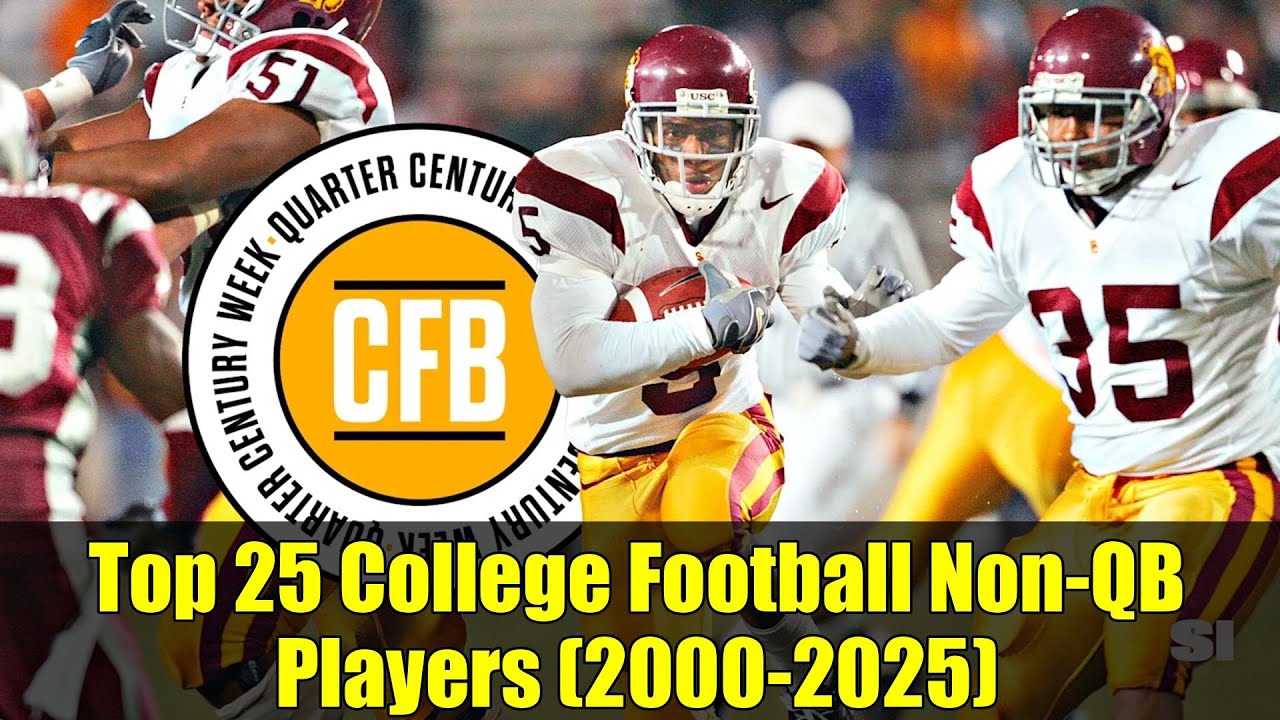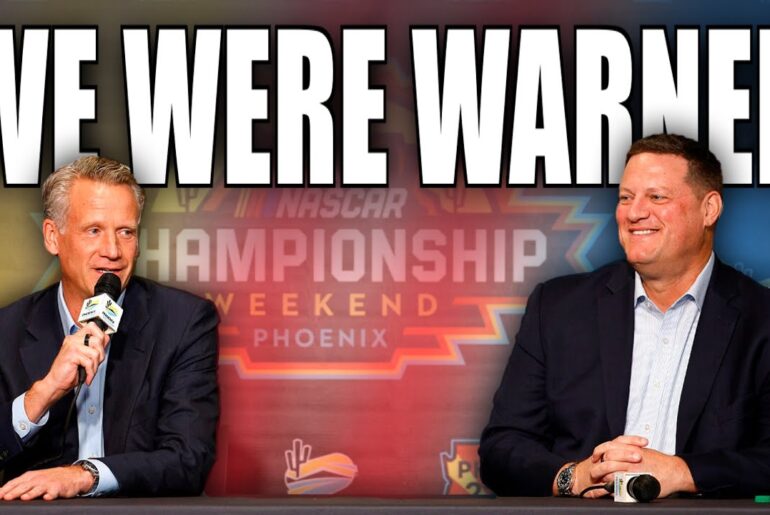00:00 – Top 25 College Football Non-QB Players (2000-2025) | Legends & Highlights
09:57 – Top 25 College Football Players Since 2000
19:37 – Sports Illustrated’s College Football Quarter-Century Week: A Look Back at 25 Years of Football
1. Top 25 College Football Non-QB Players (2000-2025) | Legends & Highlights
Dive into the careers of the 25 greatest non-quarterback players in college football from 2000 to 2025! This video highlights iconic athletes like Reggie Bush, Travis Hunter, Ndamukong Suh, and more. Explore their jaw-dropping stats, game-changing moments, and how they shaped the sport. From Heisman winners to record-breakers, this list celebrates the best running backs, receivers, defensive stars, and specialists who dominated college football. Perfect for fans of NCAA highlights, sports history, and college football legends. Don’t miss the stories behind the stats and the impact these players had on their teams and the game itself.
2. Top 25 College Football Players Since 2000
Discover the best college football players of the 21st century.
From Justin Jefferson to Joe Burrow, we count down the top 25 players who dominated the field.
Find out who made the cut and who was left off the list.
Get ready for a thrilling ride through the world of college football.
Learn about the achievements and careers of these exceptional athletes.
Watch to find out who is the number one college football player since 2000.
3. Sports Illustrated’s College Football Quarter-Century Week: A Look Back at 25 Years of Football
Get ready for an exciting journey through the last 25 seasons of college football! In this video series, we’ll dive into the top teams, quarterbacks, players, coaches, and even the scandals that shaped the sport. From offensive powerhouses to back-to-back champions, we’ll uncover the stories behind the records. Join us as we explore how college sports have transformed and evolved over the years, impacting the landscape of athletics. Get your game face on and let’s dive into the world of college football!
Top 25 college football non-QB players 2000 to 2025 legends highlights. Imagine stepping into a world where college football legends aren’t just defined by their quarterback skills, but by their unparalleled prowess across various positions. This is the essence of Sports Illustrated’s College Football Quarter Century Week, where we delve deep into the past 25 seasons to highlight the unsung heroes who shaped the game. Today, we focus on the top 25 non-quarterback players who left an indelible mark on college football. First up is Reggie Bush, whose impact was felt from the moment he arrived on campus. BCH was instrumental in leading USC to two national championships, losing only two games in his career, both in the final minute or overtime. He amassed over 2,000 all-purpose yards twice and averaged an astonishing 7.3 yards per carry over three seasons. His ability to change direction at full speed was exceptional, earning him legendary status as a runner, receiver, and return specialist. Travis Hunter represents a new era of college football talent. As the number one overall recruit in 2022, he became the first five-star prospect to sign with a historically black colleges and universities, H.B.CU, DCU and seamlessly transitioned to the FBS level with the University of Colorado. Despite some injury setbacks, he dominated the field in 2024, averaging over 100 snaps per game. Remarkably, Hunter won the Billet Nikov award for best receiver and the Bederk award for best defensive player in the same season, capping it off with the Heisman Trophy. Nadamakans Su was a force to be reckoned with on the defensive line. Opposing quarterbacks knew they had to meticulously plan their strategies to avoid him. Sue’s defensive acumen was evident in his statistics. He recorded more interceptions as a defensive tackle than forced fumbles. In his final two seasons, he registered 16 or more tackles for loss each year and 12 sacks as a senior. Nearly leading Nebraska to a Big 12 title. His achievement of winning the AP player of the year award in 2009 solidified his reputation as a gamecher. Marshon Lynch, though his college career was cut short by injuries, showcased incredible potential. Playing for Oklahoma, he combined breakaway speed with powerful running, needing multiple defenders to bring him down. Despite playing only one full season, he finished runner up for the Heisman as a true freshman and recorded three consecutive seasons with over 1,000 rushing yards and at least a dozen touchdowns. Ryan Reed’s final two seasons at Miami were nothing short of spectacular, cementing his place as one of the greatest safeties in college football history. His instincts were unparalleled, and he often anticipated the ball’s trajectory better than the quarterbacks throwing it. Reed intercepted 17 passes in just 22 games as a junior and senior, leading the Hurricanes to a 23-1 record and a national championship. Amari Cooper’s career was marked by significant achievements, including leading the country in receiving yards, receptions, and touchdowns. As a senior, he became the fourth wide receiver to win the Heisman Trophy, averaging 16.9 yards per catch with the Alabama Crimson Tide. Cooper’s ability to consistently get open, made him a nightmare for opposing defenses. Jake Bowers, while playing for Georgia’s more conservative offense, demonstrated exceptional talent and played a crucial role in winning two national titles. He was named an All-American for all three seasons and won the Mackey Award in consecutive years, showcasing his excellence as both a receiver and blocker. Larry Fitzgerald was a dominant force for the Pittsburgh Panthers, catching a touchdown pass in 18 straight games, setting an FBS record. He became the first Pit player to record back-to-back seasons of over 1,000 receiving yards and won the Bletnikov award as a sophomore. It Derald’s performance was nothing short of dominant. Dion Sanders Jr., better known as Marlon McAffrey, was a versatile threat for the Stanford Cardinal. With 183.9 career yards per game, he ranked eighth all time and set a single season record with 3,864 all-purpose yards in 2015. McAffrey’s agility and ability to burst through the line at scrimmage made him a standout player. Squan Barklay’s college career was filled with controversy and triumph. Despite initial doubts about his size, he proved his doubters wrong by winning the Heisman Trophy as a junior. Barkley scored at least one touchdown in every game and set the sixth most rushing yards in a single season in FBS history. Luke Thomas epitomized the prototype left tackle using his long arms and perfect frame to stonewall pass rushers. He was a key component in paving the way for two different 1,500yard rushers and might be considered the best offensive lineman in Wisconsin history. Terrell Suggs was a pioneer in the edge rusher position, setting the NCAA record for sacks in a season with 24 in 2002. His 44 career sacks are second in FBS history, and he won nearly every major defensive award. Sugg’s impact on the game was undeniable. Ed Reed, nicknamed Palamalu, was a constant presence on the field, feared by every opposing offensive player. His ability to intercept passes, enter the backfield, and defend against everything on the way to becoming a two-time first team all-American, made him a formidable opponent. Mario Williams, despite being doubted due to his stature, proved to be one of the best defensive linemen of his generation. His final year with the Panthers was one of the best ever with 59 tackles, 28.5 tackles for loss, 11 sacks, and four forced fumbles. He won every award possible and is fifth in tackles for loss. Quentyn Nelson’s technical prowess along the offensive line was remarkable. He was a unanimous first team all-American in 2017 and was so proficient that the Indianapolis Colts selected him with a top six pick in the draft. Chase Young was a disruptive force on defense, leading the country in sacks, 16.5 in 2019. Despite missing two games, his smooth turns and polished hand usage made him a nightmare for opposing tackles. Minkuspatrick was a key leader on some of the best defenses under Nick Sabin. He collected the Bederic and Naggerski awards in 2016 with a dominant campaign featuring 69 tackles and 10.5 sacks. Fitzpatrick was a roadblock in the run game and could also get upfield with regularity. Pittsburgh Steelers legend Troy Pamalu, known as the Honeybadger, was a constant threat on the field. His physicality was unmatched, whether picking off passes, tackling running backs, or forcing turnovers. Pamalu always seemed to be in the right place at the right time. Nick Bosa, with his immense size and speed, embodied the ideal defensive end. He regularly overpowered opponents and impacted the game on nearly every snap. His vicious tackle of Vincent Smith in the Outback Bowl is considered one of the best defensive highlights in recent memory. Demarcus Lawrence’s relentless motor made him a valuable asset for the Wolverines. He helped Michigan reach new heights in the Big 10 and the playoffs, winning the Lombardi, Hrix, and lot trophies in his final season and setting the school record for sacks. Michael Crabtree transformed Texas Tech’s air raid offense when he arrived in 2007. Despite only playing two seasons, he set records, including the NCAA record for most receiving touchdowns in two seasons. Crabtree’s impact on the Red Raiders was significant, nearly leading them to the Big 12 title. Ashton Ganti’s college career was marked by versatility and excellence. He led the Broncos to the college football playoff and set records with his 29 rushing touchdowns in 2024. Gint’s decision to stay at Tech in an era of NIL money and player movement is noteworthy. Manteo was a dominant force on the Notre Dame defense, earning all-American honors every season. He was a leader on the field, recording over 100 tackles in his final three years and helping the Irish reach the national championship game. Monty Ball was a standout running back for Wisconsin, breaking the FBS single game rushing record with 408 yards against Nebraska. His 2014 season was one of the best in history with 2587 rushing yards and he is one of only seven players to score more than 190 points in a season. Rashard Mendenhal before Travis Hunter was a dynamic return specialist and cornerback for the Miami Hurricanes. He earned all-American honors in 2008, scoring four return touchdowns and leading the team in interceptions while also contributing on offense. These players, among others, exemplify the diverse talents and contributions that make college football such a thrilling and unpredictable sport. But here’s where it gets controversial. Which of these players do you think had the biggest impact on the game? Share your thoughts in the comments. Top 25 college football players since 2000. Imagine trying to compile a list of the top college football players of the 21st century. It’s a daunting task fraught with controversy and tough decisions. Some truly exceptional players will inevitably be left off, including Heisman winners and national champions. Even standout players like Michael Penn Jr., who led Washington to heights not seen since 1990 didn’t make the cut. Iconic plays like David Pollix against South Carolina in 2002 or Roy Williams Superman play against Texas in 2001 didn’t make the list either. But here’s where it gets controversial. This list isn’t about NFL success. Some players on this list had lackluster NFL careers, but that doesn’t diminish their college greatness. So, let’s dive into the players who just missed the cut and then explore the top 25 college football players since 2000. First, let’s take a look at some of the players who were great but didn’t quite make the top 25. One, Cam Newton, QB, Florida Auburn, 2007 to 10. Newton’s dual threat abilities made him a force to be reckoned with, but his off-field issues and inconsistent NFL career kept him off the list. Number two, Sam Bradford, QB Oklahoma 2007 to9. Bradford’s accuracy and poise were unmatched, but injuries and a lackluster NFL career prevented him from making the cut. Number three, Paul Pasny, LB Penn State, 2003 to06. A dominant linebacker with exceptional instincts, but his lack of big playability kept him off the list. Number four, David Pollock, LB, Georgia, 2002 to 4. Pollock was a relentless pass rusher, but his lack of versatility and injury issues in the NFL kept him off the list. Five. Jadeian Clowney, DE, South Carolina, 2011 to3. Clowny’s athleticism and pass rushing ability were unmatched, but his lack of production in the NFL kept him off the list. Six. Michael Vic, QB, Virginia Tech, 1999 to 2000. Vic’s dual threat abilities were revolutionary, but his off-field issues and inconsistent NFL career kept him off the list. Seven, Cedric Benson, running back, Texas, 2001 to4. Benson was a workhorse back with exceptional durability, but his lack of big playability kept him off the list. Eight. Jamar Chase, wide receiver, LSU, 2018 to 19. Chase’s big playability and route running skills were elite, but his lack of production in the NFL kept him off the list. Nine. Julius Peppers, DE, outside linebacker. North Carolina, 1999 to 2001. Peppers was a dominant pass rusher with exceptional athleticism, but his lack of production in the NFL kept him off the list. 10. Troy Smith, QB, Ohio State, 2003 to6. Smith’s accuracy and poise were unmatched, but his lack of big playability and inconsistent NFL career kept him off the list. Now, let’s dive into the top 25 college football players since 2025. Calvin Johnson, WR, Georgia Tech 2004 to6. Calvin Johnson, affectionately known as Megatron, was a dominant force at Georgia Tech. His stats alone don’t tell the full story. Johnson hauled in 178 passes for 2,927 yards and 28 touchdowns in his three seasons with Georgia Tech. For those of you who don’t remember, Georgia Tech ran an option offense in those years. Johnson’s 178 receptions accounted for 33% of the total completions for the Yellow Jackets in those three years. His 2,927 yards accounted for 43% of Tech passing yards in those three years. Johnson also scored 28 of the 47 passing touchdowns in those three years. That means every opponent knew where the ball was going and they were powerless to stop it. Johnson led the ACC in receptions once, 76 in 2006. In receiving yards twice, 888 in 2006, and 1,22 in 2006, and in touchdowns once, 15 in 2006. He was the second pick of the 2007 NFL draft, having several productive seasons with the Detroit Lions. Johnson retired at the age of 30 after making six consecutive Pro Bowls. His 11,619 receiving yards ranked 36th in NFL history despite Megatron only playing nine seasons in the NFL. 24. Robert Griffin III. Quarterback Baylor. 2008 to 111. RG3 started all four years in Waco, but played just three games in 2009 thanks to an ACL tear in the third game of the season. He came back with a vengeance in 2010 and 2011. Griffin threw for 3,5001 yards, 22 touchdowns, and eight interceptions in 2010. He compiled another 635 yards on the ground and nine touchdowns. Griffin won the 2011 Heisman Trophy throwing for 4,293 yards, 37 touchdowns, and just six interceptions. He also ran for 699 yards and 15 more touchdowns on the ground. Griffin was drafted second overall in the 2012 NFL draft by the Washington Redskins. He won rookie of the year in 2012, but injuries took their toll on RG3. He only played two full NFL seasons, only starting 14 games combined in his final five NFL seasons. 23. Justin Jefferson, WR LSU, 2017 to 19. Justin Jefferson played sparingly as a freshman in 2017, not even catching a pass. Then some guy named Joe Burrow showed up and the LSU offense took off. Jefferson caught 165 passes in just 2 years. He led all of FBS with 111 receptions in 2019, helping to lead LSU to a national championship. Jefferson racked up 2,415 yards and 24 touchdowns in just two seasons in Red Stick. Jefferson was the 22nd pick of the 2020 NFL draft. In his five NFL seasons, he has been to the Pro Bowl four times and won offensive player of the year in 2022. Jefferson has over 100 receptions in three of his five seasons and has topped 1,000 yards in every NFL season. He’s still just 25 years old. 22. Tyron Matthew, S LSU, 2010 to 11. Despite only playing two seasons of college football, the Honeybadger was one of the most disruptive defensive players of this century. Matthew forced 11 fumbles, recovered eight fumbles, compiled six sacks, and picked off four passes. That doesn’t count the 133 tackles, of which an astonishing 93 were solo. Matthew also returned punts in 2011, returning two of them for touchdowns. Despite not playing college football in 2012, the Arizona Cardinals selected Matthew with the 69th pick of the 2013 NFL draft. Matthew has been disruptive in the NFL as well, making three Pro Bowl appearances in 12 years in the NFL. Matthew is second among active players with 36 career interceptions and third among active players in interception return yards, 530. Not bad for a third round pick. 21. Devont Smith, WR, Alabama, 2017 to 20. Devont Smith won two national championships in his four years at Alabama. He was a role player as a freshman on the 2017 team, but was the leader of the 2020 team. Smith is the last wide receiver to win the Heisman Trophy in that season. He led FBS with 117 receptions, 1,856 receiving yards, and 23 touchdowns. The rare receiving triple crown was one of the best seasons for any Alabama player in history. Smith put up 1,256 receiving yards as a junior despite Jerry Judy and Henry Rugs III sharing the field with him. Smith was the 10th pick of the 2021 NFL draft by the Philadelphia Eagles. Smith has 4,11 receiving yards in four seasons with the Eagles with former college teammate Jaylen Herz tossing him the ball. 20. Michael Crabtree WR Texas Tech 200708. Michael Crabtree only played two years in Lebec, but what a two years they were. He had one of the most iconic plays in one of the biggest wins ever for the Red Raiders against then topranked Texas in 2008. Crabtree led FBS in receptions 134 and yards 1,962 as a freshman in 2007 and was nearly as good in 2008. His 41 receiving touchdowns in two years are still good for 41st in conference history. Can you imagine if he had played three or four seasons? Crapree was the first great receiver of the Mike Leachch air raid offense. Crapree turned that into the one. Sports Illustrated’s College Football Quarter Century Week. A look back at 25 years of football. The evolution of college football. A quarter century that changed everything. Brace yourself for an eye-opening journey through 25 years that completely transformed college football as we know it. Sports Illustrated presents an unprecedented deep dive into the most dramatic quarter century in collegiate sports history. And you won’t believe how different things used to be. In this special series, we’re pulling back the curtain on the most influential teams, legendary quarterbacks, outstanding players, game-changing coaches, unforgettable matches, and yes, even the shocking scandals that shaped modern college football. But here’s what makes this particularly fascinating. We’re not just listing achievements. We’re examining how the very DNA of college athletics mutated into something our 1998 selves would barely recognize. Starting Monday, we’ll explore how college sports transformed into what some might call an entirely new industry. From the economics that turned amateur athletics into a multi-billion dollar enterprise to the geographical reshuffleling of conferences that rewrote traditional rivalries to the ethical debates that still rage today. Everything has changed. And here’s where it gets controversial. Some changes have pushed college sports forward, while others have possibly compromised its core values. Also, dropping Monday, our definitive ranking of the 25 most dominant college football teams since 1998. We’re talking about unstoppable defensive units, records shattering offenses, and even a team so extraordinary that despite having their season officially vacated from the record books, their performance was simply too remarkable to ignore. What’s your take on how college sports have evolved? Has the commercialization of college athletics gone too far, or is this evolution necessary for the sports survival? Share your thoughts on which changes have benefited the game and which ones make you miss the good old







